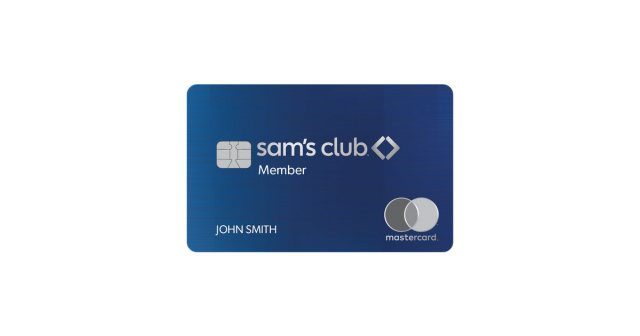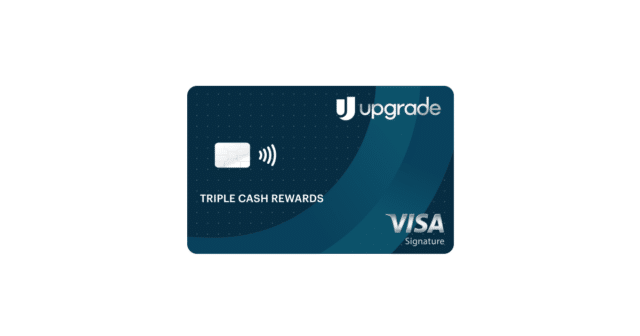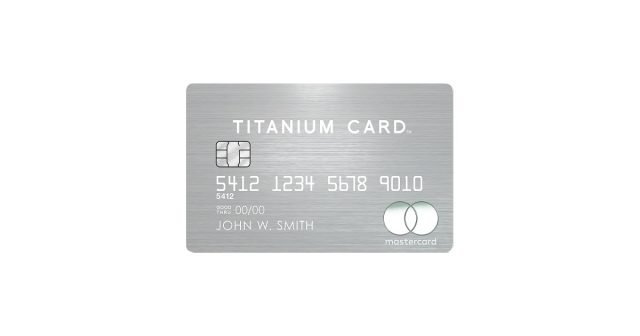by Cory Santos | Last updated on July 1st, 2025
Upgrade Cash Rewards Visa®
Upgrade Cash Rewards Visa®

Upgrade Cash Rewards Visa®
- 14.99%-29.99% variable based on creditworthiness and the Prime Rate Regular Purchase APR
- 14.99% to 29.99% Balance Transfer APR
At a Glance
The Upgrade Cash Rewards Visa® offers no fees, low rates, cash back, and credit lines from $500 to $25,000 in one unique package. The card provides consumers the flexibility and predictability to quickly pay down balances and get debt-free. The Upgrade credit card is one of the lowest regular APR credit cards on the market for those with excellent credit scores, putting it firmly on any list of the best balance transfer credit card deals – or any list of the best credit cards in the U.S.
- Best Benefits
- Rates & Fees
- Why Should You Apply?
- $200 bonus after opening a Rewards Checking Preferred account and making 3 debit card transactions*
- 1.5% unlimited cash back on every purchase
- No annual fee
- See if you qualify in seconds with no impact to your credit score
- Combine the flexibility of a card with the predictability of a personal loan
- Enjoy Visa Signature benefits, like Roadside Dispatch, Price Protection, Extended Warranty Protection, and more
- Shop smarter with Upgrade Shopping! Get exclusive savings at stores, restaurants, and more
- Contactless payments with Apple Pay® and Google Wallet™ bull; Mobile app to access your account anytime, anywhere
- Use your card anywhere Visa is accepted
- Relax knowing that you are protected in case of unauthorized transactions with Visa’s Zero Liability Policy
- Regular Purchase APR: 14.99%-29.99% variable based on creditworthiness and the Prime Rate
- Balance Transfer APR: 14.99% to 29.99%
- Balance Transfer Transaction Fee: Up to 5%
- Foreign Transaction Fee: Up to 3%
- Late Payment Penalty Fee: May apply
- You struggle to pay off your credit card balances
- You want a structured repayment plan
- You can reliably pay off your statement balances to earn cash back for your purchases
- You have a desire to get debt-free quickly
- You hate penalty or other hidden fees
In-Depth Review: Upgrade Cash Rewards Visa®
The Upgrade Card offers a unique take on what a credit card can be. The card, issued by Cross River Bank, blurs the lines between a personal credit card and a personal loan. This provides cardholders the predictability and low rate of a personal loan and the flexibility of a credit card – all in one package.
Who Can Benefit from the Upgrade Cash Rewards Visa®?
The hybrid nature of the Upgrade Card makes it an excellent option for those who struggle with making payments with their regular credit cards. The structure of the installment plan makes it ideal for those who need help paying down their debts. This is especially true for those who prefer to carry a balance on their cards.
While the Upgrade Card doesn’t allow balance transfers per se, the ability to transfer some (or all) of the available credit line to an existing bank account makes it perfect for immediately eliminating an individual’s card balances. Once they do this, they can pay down one balance instead of several. This, in turn, can boost their credit score and reduce their monthly outlay. And, like other credit cards, Upgrade provides free access to credit monitoring tools, making it easy to track potential credit score growth.
How Upgrade Works
The Upgrade Card works in two ways. Cardholders can use their line of credit to make purchases anywhere Visa is accepted worldwide. They can also choose to have some of the funds from their credit line transferred to their bank account, to help tackle existing debt. This latter method makes the card a useful alternative for a balance transfer credit card.
Once the statement period ends, Upgrade lumps all bank transfers and purchases into one balance, which the account holder then pays down based on their installment terms. As noted, these terms range from 12 months to 60 months. During subsequent statement periods, cardholders can continue making purchases or transferring funds to existing bank accounts up to their credit limit, with the process repeating itself.
Pay Off Balances Faster
Thanks to the excellent APR (in comparison with other low APR credit cards), the card makes paying off existing debts almost effortless. While interest rates with the card vary depending on creditworthiness, those with excellent credit scores can expect an APR almost eight percentage-points lower than found with the best credit cards.
This exceptional rate makes accelerates debt repayments, with many Upgrade Cardholders eliminating balances years before those with traditional credit cards. Not only does Upgrade make paying off debt more manageable, but it also dramatically reduces the amount of interest paid at the same time.
According to research from Upgrade, paying off a $10,000 balance takes just a few years with the Upgrade Visa, compared with other traditional credit cards that can take up to 20 years – or more.
How to Earn Cash Back
Another unique aspect of the Upgrade Cash Rewards Visa® lies in its name: it earns cash back. A credit card designed to help consumers pay down their debt faster typically does not focus on rewards – or even have a rewards scheme. But the Upgrade Card is designed to be different. Card members will be able to earn unlimited 1.5% cash back on anything they purchase (except for non-purchase transactions, like sending electronic funds).
There is, however, a catch to earning cash back. Members will only get rewarded after they pay off their purchases via their billing statement. This condition ensures that cardholders remain responsible in paying off their debt, which can go a long way towards developing healthy money habits. Upgrade’s approach to cash back is similar to the Citi® Double Cash Card – 18 month BT offer. That card earns 1% cash back on purchases immediately and an additional 1% after those purchases are paid off.
Other Card Benefits
As an Upgrade cardholder, you can expect an array of helpful tools, security features, and more. All Upgrade Cards feature EMV chip technology, allowing you to shop with an additional layer of security in-store and online. EMV chips let you tap and pay at retailers worldwide, streamlining your buying experience and keeping you safe.
No Worries About Fees
The Upgrade Card positions itself as a different kind of credit card, so eliminating common fees keeps it true to its mission statement. The card has $0 annual fee and $0 activation fees.
Visa Signature Benefits
- Zero Fraud Liability
- Cardholder Inquiry Services
- Emergency Card Replacement
- Luxury Hotel Collection
- Extended Warranty Coverage
- Roadside Dispatch
- Lost/Stolen Card Reporting
- ID Navigator from Norton
- Travel & Emergency Assistance
Comparison
TD Clear Comparison
The TD Clear is an interesting low rate and balance transfer credit card from TD Bank. The card offers credit limits of $1,000 to $2,000 and works by charging no interest charges, instead opting for a simple, predictable minimum monthly payment and flat monthly fee of $10 or $20 ($120 or $240 annualized). This means you can expect a minimum monthly payment of around $45+ and a straightforward way to pay off debt akin to Upgrade. Where Upgrade trumps the TD Bank Clear Card, however, is its generous credit limits (up to $25,000) and cash back rewards on all eligible purchase.
Upgrade Card Comparison
The Upgrade Cash Rewards Visa® offers 1.5% unlimited cash back on card purchases every time you make a payment. On the other hand, the Upgrade Triple Cash Rewards Visa® provides unlimited cash back on payments – 3% on Home, Auto, and Health categories and 1% on everything else.
Both Upgrade Visa cards share the following benefits:
- They combine the flexibility of a credit card with the predictability of a personal loan.
- They feature no-touch payments with contactless technology built in.
- Individuals can check if they qualify in minutes without hurting their credit score.
- There is no annual fee for either card.
What We Like About the Upgrade Cash Back Card
Cash Back for Fair Credit
Perhaps the best aspect of Upgrade’s credit cards is that they are available to applicants with a FICO credit score of 600 or above. This means the Upgrade Cash Rewards Visa® is perfect for with less-than-stellar, near-prime credit.
Unlimited Cash Back
The Upgrade Cash Rewards Visa® earns an unlimited 1.5% cash back on all purchases, just with a twist. Cardholders earn their cash back when they pay the balance on their card the following month. While this process may not be for everyone, it’s similar to having rewards earned with the TD Double Up Card and the Citi Double Cash Card.
Things to Consider
No Welcome Offer Outside Checking Bonus
The Upgrade Cash Rewards Visa® does provide a welcome bonus. Unfortunately, that welcome offer is tied to the fintech’s’ rewards-checking program. While that sign-up bonus is a $200 value, it requires opening a checking program, meeting account deposit minimums, and making at least three purchases within the first two months of account opening. This can be frustrating if you misread and think you’ll get a $200 statement credit – you won’t.
Upgrade FAQs
- Yes! The Upgrade Card is a regular Visa credit card that also acts as an installment loan.
- Unlike other cards, Upgrade is reported as an installment loan on your credit report.
- The card requires a fair credit score or higher. Those with a credit score of 620 or more are eligible for the card, while those with lower credit scores should consider another credit card for rebuilding credit.
- Yes. Upgrade reports to Equifax, Experian, and TransUnion.
- Upgrade Loans are different from the Upgrade Visa® Card with Cash Rewards. Upgrade Loans may contact your employer to verify employment and income details. The Upgrade Card, however, acts like any other credit card application, meaning you won’t have to worry about your employer being contacted.
- The Upgrade Card is available in all 50 U.S. states plus the District of Columbia (DC).
Why Consider Upgrade?
Many credit cards come with the offer of 0% intro APR. These introductory bonuses are designed to help cardholders pay down existing balances.
The Upgrade Card takes this concept and turns it on its head. Gone is the introductory offer. Instead, cardholders get a lower rate and an installment plan based on their creditworthiness.
The Upgrade Card isn’t exactly a credit card. Nor is it exactly a traditional loan. Instead, the Upgrade credit card is an easy-to-use credit line with installment plans of 12, 24, 36, or 60 months. These periods vary depending on the creditworthiness of the applicant. The APR with the Upgrade Visa Card also varies depending on the creditworthiness.
Upgrade Card Ratings
How does the Upgrade Card stack up? Here is a selection of expert reviews for the card:
| BestCards | Better Business Bureau | TrustPilot |
|
5/5 |
5/5 |
5/5 |
Should You Apply for the Upgrade Cash Rewards Visa®?
The Upgrade Card is a refreshing approach to the traditional credit card. Balance transfer cards are great because they allow cardholders to reduce balances by combining them and paying them down over time. Typically, this involves a 0% intro APR period.
Upgrade Card, on the other hand, offers a credit line which the cardholder can use to pay off their balances. Once they accomplish this, they can pay off the card balance over a set installment period. Even better, most cardholders get interest rates, which are dramatically lower than those found with the most economical, low APR credit cards.
In addition, the cash back rewards component adds a huge dose of appeal. The fact that customers can earn 1.5% back on all purchases without caps gives the Upgrade Card an incentive not typically seen in cards designed to help people chop down their debt. Other popular no annual fee options include the Citi® Double Cash Card – 18 month BT offer (unlimited 2% back), WF Active Cash (also 2% back) and the Citi Custom Cash℠ Card.
Ultimately, the Upgrade Card is an excellent – and unique – alternative to the balance transfer card for those with great or good credit scores. The lack of an annual fee, excellent interest-rates, and generous repayment terms make it ideal for those who struggle to pay off their debts – and need a helping hand in the process.
Welcome Bonus Disclosure: *To qualify for the welcome bonus, you must open and fund a new Rewards Checking Preferred account through Upgrade and make 3 qualifying debit card transactions from your Rewards Checking Preferred account within 60 days of the date the Rewards Checking Preferred account is opened. If you have previously opened a checking account through Upgrade or do not open a Rewards Checking Preferred account as part of this application process, you are not eligible for this welcome bonus offer. Your Upgrade Card and Rewards Checking Preferred account must be open and in good standing to receive a bonus. To qualify, debit card transactions must have settled and exclude ATM transactions. Please refer to the applicable Upgrade Visa® Debit Card Agreement and Disclosures for more information. Welcome bonus offers cannot be combined, substituted, or applied retroactively. The bonus will be applied to your Rewards Checking Preferred account as a one-time payout credit within 60 days after meeting the conditions. This one-time bonus is available through this Upgrade Card offer and may not be available for other Upgrade Card offers.
State Exclusions: DC, IA, WV, WI, GA, MA
Credit Lines feature Annual Percentage Rates (APRs) of 14.99% – 29.99% and line amounts ranging from $500 – $25,000 based on creditworthiness. The lowest rates require Autopay and the majority of line amounts will be $15,000 or under. For example, a $1,000 card purchase with a 36 month term and a 19.99% APR has a monthly payment of $37.55. Optional cash transfers to your bank account and balance transfers are subject to a fee of up to 5% of each draw or transfer. Foreign transactions are subject to a fee of up to 3% per transaction. ATM withdrawal fees may apply. If incurred, these fees will increase your finance charge and APR. A late fee of up to $29 per late payment may apply. Your rate, line amount, and default term depend on maintaining a qualifying credit score, your credit usage history, requested amount, and other factors. The Upgrade Card is unique in that it allows you to obtain a series of closed-end loans which you may access through transactions such as card purchases up to your approved amount. As you repay your balance, additional credit may become available to you up to an approved amount subject to meeting our credit requirements, but your line will not replenish automatically.
Browse Other Card Offers:
Editorial Disclosure – The opinions expressed on BestCards.com's reviews, articles, and all other content on or relating to the website are solely those of the content’s author(s). These opinions do not reflect those of any card issuer or financial institution, and editorial content on our site has not been reviewed or approved by these entities unless noted otherwise. Further, BestCards.com lists credit card offers that are frequently updated with information believed to be accurate to the best of our team's knowledge. However, please review the information provided directly by the credit card issuer or related financial institution for full details.



